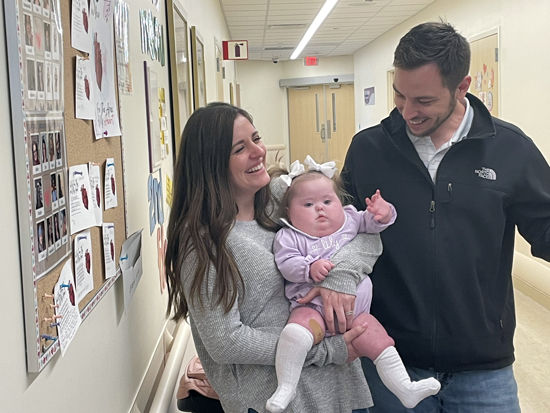
Surgeons at Monroe Carell Jr. Children’s Hospital at Vanderbilt recently performed an innovative surgery to repair a rare esophageal condition in a 9-month-old patient.
The hospital is the first in the state to use the thoracoscopic Foker process, a minimally invasive technique, to repair long-gap esophageal atresia also known as Type A EA.
“This unique expertise was previously not available in our state and is offered at only a few centers nationally,” said Jamie Robinson, MD, MS, PhD, assistant professor of Pediatric Surgery at Monroe Carell. “We now have the opportunity to provide a novel approach to the repair of this complex esophageal condition to patients throughout the region.”
The Foker process uses traction to gradually lengthen or stretch the esophagus until the upper and lower ends are close enough together to surgically join them.
Lily Hale was the first patient to undergo the revolutionary procedure at Monroe Carell.
At 6 days old, Lily was transferred to Monroe Carell with a congenital heart defect that required urgent attention. She underwent two heart repair surgeries within the first month of her life. A final cardiac surgery in December placed Lily in a good place for the esophageal procedures that would allow her to swallow her own saliva and eventually eat and drink by mouth.
The life-changing procedures, seven in total, began on Feb. 21 with the last surgery on March 23 that finally joined the two ends of her esophagus.
“We knew that the team at Monroe Carell has done multiple EA repairs, but had not used the Foker,” said Jessica Hale, Lily’s mom. “We had learned about this process from researching and found it was done at Boston Children’s Hospital, which is so far away from home.
“It was the method we felt best about and would have the best outcome. We had a big decision to make,” said Hale.
While Lily was hospitalized for her cardiac issues, the Hales — Jessica and her husband, Wesley — spoke with Bo Lovvorn, MD, professor of Pediatric Surgery and medical director, Pediatric Trauma Program at Monroe Carell, about Lily’s complex esophageal issues.
He introduced the family to Robinson, the newest member of the surgery team, who had trained at Boston Children’s where she learned how to perform the Foker procedure.
“A lot of the reason we decided to stay at Monroe Carell was that both Drs. Lovvorn and Robinson were working together; we had a veteran surgeon and another one with experience in the procedure we needed.
“They really connected very well with us. They were very real about the situation, and they were great about communicating with us to address any concerns. I felt a wave of peace and confidence.”
Hale said she is glad that they have provided a pathway for other families.
“The biggest thing, no matter where you are, is to advocate for your child. It is amazing that families will not have to travel all over the country to find help. I couldn’t be more pleased that Dr. Robinson learned this method and is able to bring that expertise and care here.”
Robinson and her team feel that Monroe Carell is poised to become a leading center in complex esophageal and airway disease.
EA occurs in 1 in 4,500 births, but the more complex form that Lily developed is seen in less than 10% of children born with EA.
“This technique, along with our growing program, will improve our ability to offer multidisciplinary continuity of care for patients with this condition,” added Robinson.
Lily is thriving at home, according to her mom. She joins big brother, Hunter.
“She had never been home,” said Hale. “We are all here together. She blossomed after her heart surgeries and then after the connection procedures. She is just the happiest baby and is so different.
“I definitely want other families to know there is a light at the end of the tunnel for so many different conditions.”












